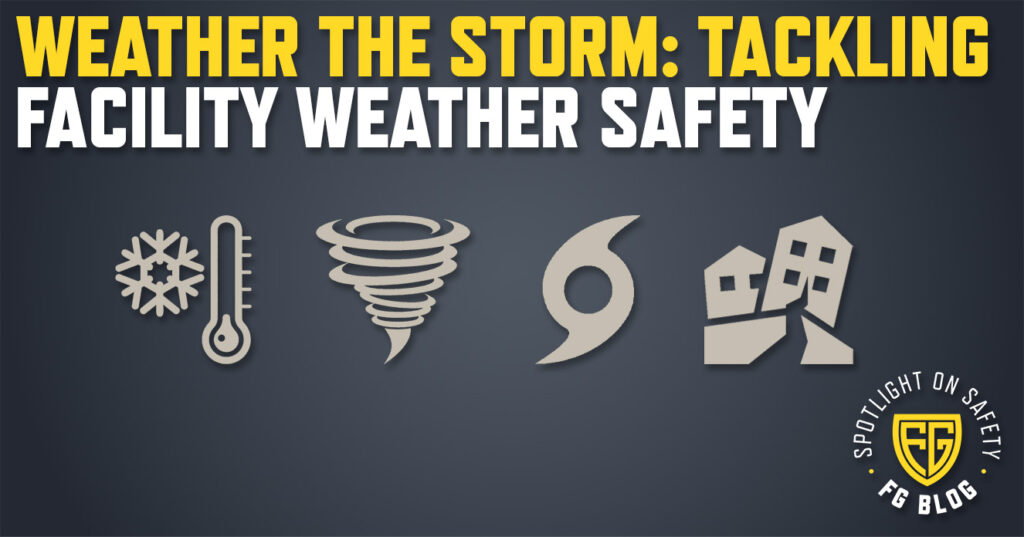Weather The Storm: Tackling Facility Weather Safety

It’s time for another Spotlight on Safety, where we like to take an in-depth look at safety precautions and best practices for warehouses and manufacturing facilities. This month, we’re going to explore how to best prepare your facility for inclement weather.
With spring finally arriving after an excessively long winter, nasty weather is probably the last thing anyone wants to think about right now. But as anyone who’s ever been caught unaware in a safety emergency can tell you, taking precautions now is the best way to prevent a disaster later.
Winter Weather Preparation
Since we’re all trying to put winter behind us, let’s get winter weather precautions out of the way first. If your facility is located in an area that experiences a strong winter climate, you know how snow, sleet, and ice can slow or even stall production and shipping on a bad day. To keep that bad day from becoming worse, however, there are several steps you can take that will keep your employees and your inventory safe.
- Ensure employees are outfitted with weather-safe footwear to avoid slipping. Snow and sleet can get tracked into the workplace during winter, and the parking lot can get icy. If employees have proper footwear, you can prevent potentially dangerous slips.
- Ensure the parking lot and the loading dock are clear of ice and snow to prevent not only employee accidents in the parking lot, but inventory and property damage at the loading dock.
- Protect employees who work in exposed areas (like the loading dock) from exposure and cold stress by providing frequent short breaks and proper outerwear.
Natural Disaster Weather Safety
Winter weather isn’t the only naturally occurring safety concern that affects warehouses and manufacturing facilities. All over the country, businesses are susceptible to various kinds of extreme natural disasters. Hurricanes, earthquakes, tornadoes, and more are safety concerns that your facility can and should be prepared for depending on your location.
Last month, we looked into the benefits of creating an Emergency Action Plan. Your EAP should include plans for any kind of natural disaster that may occur in your region. You should conduct frequent drills so that your employees know where to go and what to do in case of each specific emergency.
Tornado Preparedness
If your facility is located in a region that could experience tornadoes, here are some precautions you can take in addition to frequent drills:
- Develop a system (whether it be through clock-ins or a fob scanner to unlock the doors) to know who is in the building at any given time. This way, you can take an accurate roll call after evacuating to the tornado shelter.
- Assign specific emergency duties to specific job roles or personnel to ensure that someone will always be able to complete those specific emergency tasks outlined in your EAP.
- Frequently test alarm systems, and develop a way to communicate the nature of the emergency to employees with disabilities, or those who do not speak English.
- Have a designated safe space in the interior of the facility (without windows) that can function as a tornado shelter.
Hurricane Season Precautions
If your business is located near a coast and you might experience hurricanes, here are some precautions you should take:
- Have a chain of command, evacuation procedure, and emergency functions outlined in your company’s EAP, and ensure each employee is trained to follow the plan.
- Make sure you and your employees (especially those who might activate the EAP) are familiar with the Saffir-Simpson Hurricane Wind Scale (the category-based system that designates the wind speed and danger of a hurricane in categories 1-5).
- Have emergency supply kits ready and stocked in your shelter locations.
Preparing Your Facility for Earthquakes
If your facility is located in a region that might experience earthquakes, here are some precautions you can take:
- Conduct frequent drills and teach your employees the “drop, cover, and hold-on” method.
- Ensure that your workspace has multiple “safe places” such as sturdy tables or desks under which employees can take shelter during an earthquake.
- Make sure your EAP includes a plan for earthquakes, and ensure that all employees are familiar with the procedure they must follow in the event that an earthquake does occur.
Above All – Be Prepared
The ultimate takeaway when it comes to protecting against inclement weather is PREPAREDNESS. If you’re prepared for a disaster, as unlikely as it may be, you can better face it if it comes.
Include plans for potential natural disasters appropriate for your region in your company’s Emergency Action Plan. Conduct frequent drills of your EAP so that muscle memory can take over in the face of a panic-inducing situation. These simple steps can save lives.
For more guidance on how to handle specific weather-based emergencies, visit osha.gov.
To learn more about a wide variety of facility safety topics, visit the Spotlight on Safety page of the Folding Guard blog!
